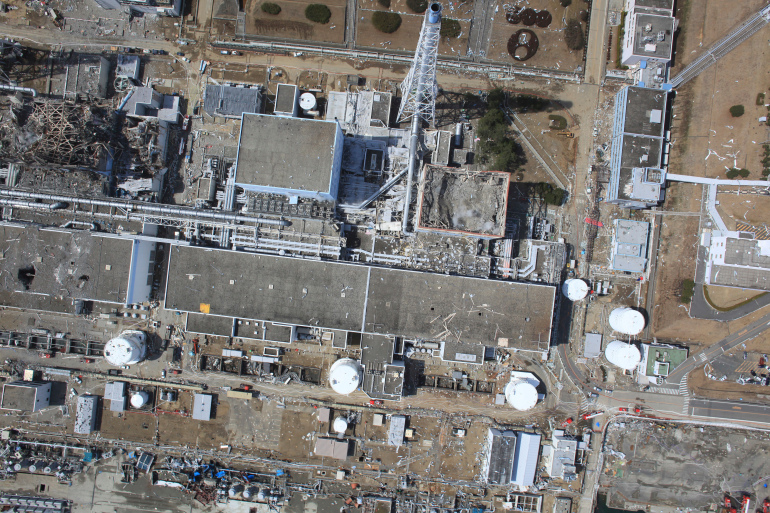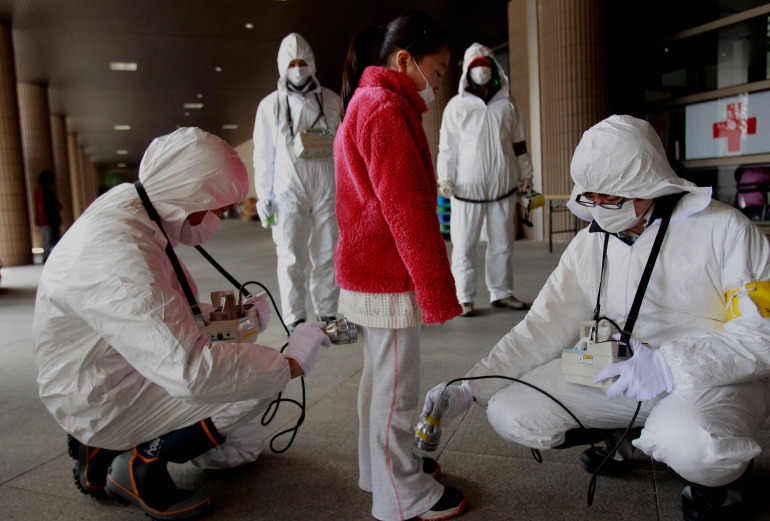Ten years after a tsunami hit the Fukushima Daiichi nuclear plant in northeastern Japan, controversy and doubts over its clean-up efforts continue to dog the industry. And the voices calling for the government to embrace alternative, greener forms of energy and to decommission its nuclear reactors have only grown louder.
After Fukushima was swamped by a tsunami that left three of its reactors in meltdown in 2011, its opaque decommissioning process has ensured the crippled plant remains in the spotlight as authorities debate what to do with the nearly 1.25 million tonnes of radioactive water used to cool the melted reactors down.
The contaminated water is currently housed in about 1,000 thousand metal tanks on the grounds of the plant and the authorities say that there is little space for more.
Widely reported plans to dump the water into the Pacific Ocean have created national and international alarm. The concern has delayed the authorities’ decision about the radioactive waters’ release but no answers have been forthcoming since then.
Prime Minister Yoshihide Suga, touring the nearby city of Minamisoma on Saturday, said that the water disposal policy would be decided “at an appropriate time and in a responsible manner.” But he added: “We can’t delay our decision indefinitely”.
The plant’s owner, Tokyo Electric Power Company (TEPCO) has treated the contaminated water through what it calls the Advanced Liquid Processing System (ALPS), noting on its website that this “eventually removes most of the radioactive materials except Tritium.”
Tritium, explains Ken Buesseler, a senior scientist at the Woods Hole Oceanographic Institution, is “one of the least harmful” radioactive isotopes, and may not pose any significant threat to human health.
Much larger amounts of Tritium have already been deposited in the seas, since hundreds of nuclear reactors around the world are allowed to release it and because nuclear weapons tests conducted in the Pacific in the 1950s also discharged it into the surrounding oceans.
However, Buesseler says there are more serious grounds for concern about the other more dangerous elements that will be discharged when water from the Fukushima Daiichi is let out into the sea.
Unlike the gases that escaped from the plant in high volumes in the early months of the crisis, he says, the kinds of radioactive contamination found in the waters used to cool the reactors is “a completely different beast” that includes far more dangerous isotopes such as Cobalt-60, Strontium-90, and Caesium.
By TEPCO’s own account, ALPS has “reduced” concentrations of these much more concerning isotopes but it has not eliminated them.
“What else is in the tanks is an important question before you decide what to do with it,” cautioned Buesseler, one of the world’s top experts on the issue.
While the data issued by TEPCO is incomplete, Buesseler estimates that about 70 percent of the “treated” Fukushima water in the tanks needs additional processing and that independent experts need to be brought in as part of a careful verification process.
Trust undermined
The challenge faced by the Japanese government and TEPCO is also a legacy of poor communication, concealment and misinformation about nuclear safety issues at the Fukushima plant.
“It was always: ‘Trust us, and we’ll engineer solutions’,” noted Buesseler, “I think they lost the public trust very early… So once you lose that trust, it’s hard to rebuild, and I think that still plagues them to this day.”
In the months and years that followed the 2011 disaster, a series of revelations badly damaged TEPCO’s reputation.
One of the gravest charges was that the company’s own internal studies had concluded prior to the accident that the plant might be vulnerable to a large tsunami and needed a protective barrier.
The finding was later rejected because top executives felt that the construction of the wall would be too expensive. But even after the disaster happened TEPCO and the government regulators continued to argue that such a large tsunami hitting the plant had been “unforeseeable.”
 The Fukushima plant pictured two weeks after the tsunami showing the damaged reactors one to three [File: AIR photo service via AP]
The Fukushima plant pictured two weeks after the tsunami showing the damaged reactors one to three [File: AIR photo service via AP]
In the months after the accident, all 54 of Japan’s nuclear reactors were taken offline and the government put new safety regulations in place. The discredited Nuclear and Industrial Safety Agency (NISA) was replaced by the Nuclear Regulation Agency (NRA), thought to be less under the government’s thumb.
But these measures have done little ease people’s concerns about the risks of nuclear power.
A large public opinion poll conducted by national broadcaster NHK at the end of last year found that only 3 percent of the Japanese public believed that nuclear power should be expanded, compared with 50 percent who felt that it should be reduced and 17 percent who wanted its immediate abolition.
The Japanese government’s current energy plans, however, call for a significant expansion of nuclear power arguing that it remains a dependable energy source that does not contribute to climate change.
In the 10 years since the Fukushima disaster, the pro-nuclear government and the anti-nuclear citizen activists brought various cases to court and now appear to be at an impasse. The anti-nuclear camp was not able to prevent the government from restarting Japan’s nuclear plants – but Tokyo has not been able to achieve the nuclear goals it originally set out for itself.
“Even 10 years after the Fukushima accident, the government and the incumbent utilities could only reopen nine reactors,” observed Mika Ohbayashi, the director of the Tokyo-based Renewable Energy Institute. The country had 54 reactors in operation before the tsunami struck.
Today, nuclear power only contributes a little over 7 percent towards the nation’s electricity supply – not between 20 and 22 percent as originally planned, powered by the restarting of about 30 reactors. Few independent observers regard the plan as plausible.
Deep divisions
Many activists, among them Caitlin Stronell, the editor of Nuke Info Tokyo at the Citizen’s Nuclear Information Center in the Japanese capital, are flummoxed by the Japanese government’s resistance to what they regard as the obvious and only viable solution going forward – an substantial shift towards renewable energies such as solar and wind power.
Stronell scoffs at arguments that renewables are not a viable solution for Japan due to engineering challenges.
“They think that they can look after radioactive fuel for 10,000 years. They have the technology for that,” she said. “But they can’t save sunshine overnight in a battery?”
Stronell believes that the falling costs of renewables and the rising costs, financial and political, of trying to build nuclear plants and the disposing of radioactive waste may make the outcome a foregone conclusion.
“Even if it’s a business decision, nuclear power just doesn’t pay any more. It’s really expensive,” she said.
Even as Japan and the world mark 10 years since Japan’s magnitude 9.0 earthquake, tsunami and nuclear disaster, there is much ground that remains contested.
 The disaster forced the evacuation of tens of thousands of people from communities in and around the Fukushima plant after the 2011 disaster [File: Wally Santana/AP]
The disaster forced the evacuation of tens of thousands of people from communities in and around the Fukushima plant after the 2011 disaster [File: Wally Santana/AP]
Kyle Cleveland, an associate professor at Temple University Japan and co-editor of the forthcoming book Legacies of Fukushima: 3/11 in Context, observes: “Fukushima sits behind Chernobyl as the one of the most significant nuclear accidents in world history.”
Chernobyl released more radiation into the environment and killed more people, but the fallout from Fukushima – the world’s second-worst civilian nuclear disaster – continues to be felt, affecting Japan’s economy – especially in Fukushima Prefecture – and colouring the debate over its national energy policy.
The impact of radiation on human health also remains under scrutiny, whether it be encouraging Fukushima residents to return to their homes, or the decision of what to do with the water used to cool the melted reactors.
There remains no common ground between the pro-nuclear Japanese government camp and the anti-nuclear activists who challenge them – even on basic medical facts.
“Often when people are debating radiation effects, they aren’t really talking about radiation,” Cleveland said. “They are talking about politics. It’s a proxy for politics.”





